Contrary to popular belief, at least in America, Jörg Buttgereit is not just the director of the arguably notorious NEKROMANTIK. He is also a playwright, a producer, an author, a bastion of good taste, and a sharp dresser.
I had the pleasure of speaking to Mr. Buttgereit a couple weeks ago…AT FOUR IN THE MORNING.
Fortunately, he’s a fascinating individual, and I didn’t fall face-first into my tub of coffee.
Let’s jump right into snappy answers to stupid questions…
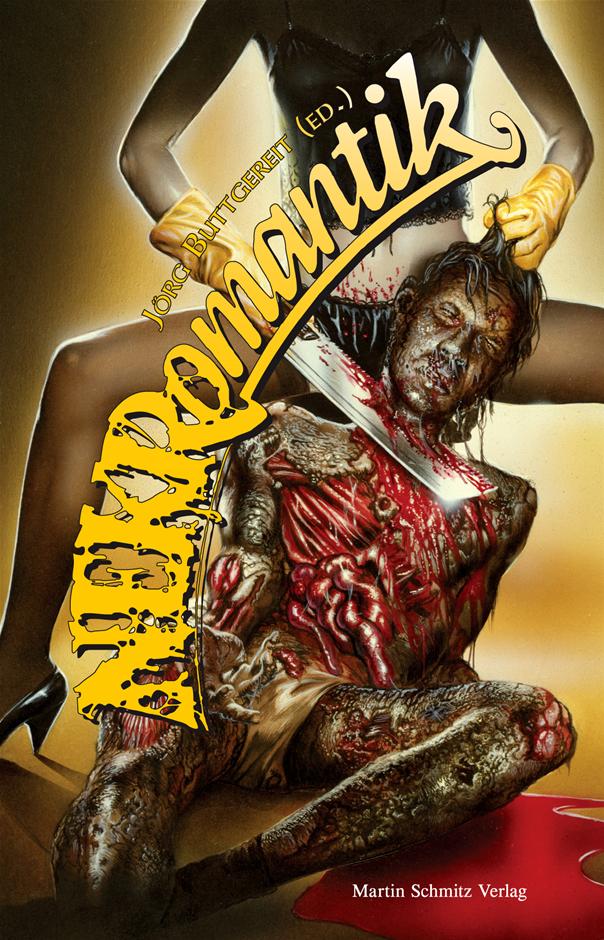
Daily Grindhouse: What was the first movie that changed your life?
Jörg Buttgereit: That’s hard to say, because normally you don’t remember the first thing you see. One of the first memories I have is of a very early Ray Harryhausen movie THE 7TH VOYAGE OF SINBAD – with the Cyclops. That really freaked me out. That was one of the few films shown on TV in Germany. There was no real horror culture in Germany, so films like that on TV were very rare. I think this was the first movie I ever saw.

Do you think there’s a line between making a good film and simply making a film to startle the audience – shock for the sake of shock?
Yes, of course. There are so many films that pretend to be shocking, but they are so bad that the shock doesn’t work. I think the most shocking and disturbing films are never the ones that tell me upfront that the film is shocking. I’m shocked when I’m not expecting a shock. If you speak of NEKROMANTIK, the poster is really shocking, but then you see that the film does not deal with the subject in a shocking way. It pretends that it’s all normal. The topic is shocking in the first place, but the movie deals with the subject like it’s a normal love story. The second part is worse in this case, you only have two or three scenes that are shocking, and the rest is pure love story – which might be shocking to horror fans. You get shocked by things you do not expect. If you can prepare yourself, you are not shocked.
Was your short HOT LOVE somewhat of a precursor to NEKROMANTIK? Did one inspire the other?
No. I got the chance to do NEKROMANTIK because of my collaboration with the producer on a documentary about a famous punk club here in Berlin. Like CBGB’s in New York, we still have a club over here called S.O.36-an old name for the district where the club is located. Manfred Jelinski, the producer, asked me if I could help him with this documentary because I had contacts with the music scene. He looked like a hippie, so he wasn’t even allowed sometimes to go in the club. I contacted all the punk and industrial bands that were popular during that time and we did the documentary film together. After that film – that was in ’84 – he was willing to support me with equipment, editing facilities, and a cameraman to do my first feature film. Before that, he also made the blow-up for HOT LOVE. He had a machine to do film prints from Super 8. When you do Super 8 films, and HOT LOVE is a Super 8 film, you don’t have a negative. You can’t do prints like you can from photos. From the original Super 8 film stock, he made a 16mm blow-up for cinema screens. After that he told me, “We worked together on the documentary film and I’ve seen your last short film. If you want to do a feature film – you won’t get any money – but you can work with my facilities.”
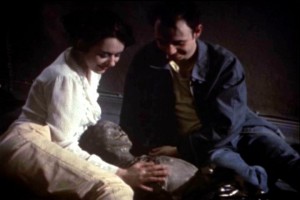
When I watched HOT LOVE, obviously, it’s not the same story as NEKROMANTIK, but it has the same star and a similar feel. Could it be argued that NEKROMANTIK is a love story?
In every love story movie, you have a relationship between three people where something goes wrong. I think that is typical love story stuff. One is dead in NEKROMANTIK. That’s the only difference.
http://www.youtube.com/watch?v=PKmYzfItd5s
What’s your take on contemporary horror? To me, it seems like the European filmmakers are pushing the boundaries nowadays: You, Srdjan Spasojevich with A SERBIAN FILM, Pascal Laugier with MARTYRS, and even Tom Six with his HUMAN CENTIPEDE series. America seems to be content doing horrible remakes like NIGHTMARE ON ELM STREET, or flaccid original films like INSIDIOUS. Do you feel like Europe is just simply where it’s at for horror that pushes the boundaries?
When I pushed the boundaries 25 years ago, there was really no European horror scene. There was no German horror scene until now. What I did was more like underground filmmaking based on the punk rock movement. When I saw the fringe horror movies like INSIDE or MARTYRS, I noticed they also had good plots. Over here, the movies have disturbing thoughts. They try to do more than an American horror movie likes to do. I think that’s also because in Europe, it’s not so common to deal with horror in entertainment. Here, you need an excuse to do a horror movie, because you have to explain yourself. Over there, in the US, doing a horror movie is nothing special, I suppose. Over here, it is something ‘bad’ in the first place, and you have to explain yourself. In the long run, this might be the reason people have to think more about what they are doing. Maybe European filmmakers are forced to put sense into their movies.
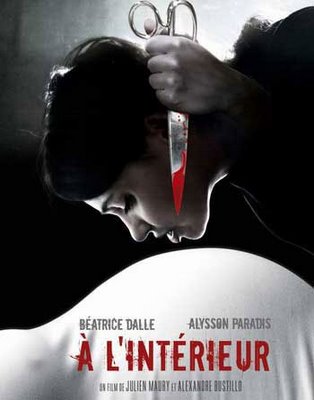
You were saying, especially back in the day, Germany wasn’t making horror movies. German horror seems to be somewhat popular nowadays.
What is German horror?
Olaf Ittenbach’s BURNING MOON, for example; although it came out in the late eighties, it recently had an impressive re-release from Intervision on DVD.
That has nothing to do with any film scene over here. That was just a guy doing his home movies. You can look in a German film dictionary and you won’t find him. You might not even find me. Over here, I’m more known for writing film critiques on horror movies, or writing books about Japanese monster movies. I’m not part of any industry. I started earning money doing films when I stopped doing horror movies. I earn my money with stage plays and radio plays – stuff like this. I’m also kind of bored by horror movies. Someone like Olaf Ittenbach cannot live on making horror movies. There is no film industry; we are not supported in any way. It’s totally different. Sometimes there are films that are more commercial. The producers have it in mind to export the films. If you want to be a filmmaker in Germany, you don’t do horror films. It’s a bad decision. Speaking of a career move, it’s the worst you can make.
Would you consider Uwe Boll to be part of the German horror scene?
When I did films in the eighties, we had to establish our own distribution company, or they wouldn’t have been sent out or even released. We also distributed Uwe Boll’s early films. That’s why I know of his early films. I think he’s a total exception in terms of how many movies he can do and that he earns money with the movies. But his films are totally different from the films I did and the films Ittenbach is doing, because his appeal is totally commercial. I would assume that he doesn’t even think about trying to tell something to the audience. He’s trying to sell something to the audience, that’s his main thing. I think he’s a very clever producer, but not a high-profile filmmaker. I think he directs his films because it’s cheaper for him.
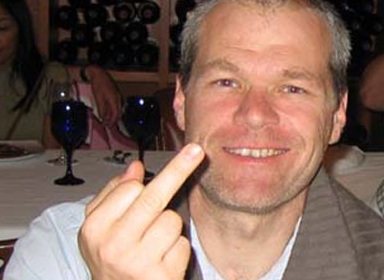
NEKROMANTIK is arguably your most famous-perhaps infamous-film. Is there another movie in your filmography that you feel fell under the radar – maybe didn’t get the attention it deserved?
I’m very surprised I get any attention for my movies at all, because the four feature films I did were films I did on weekends with my friends. This was the internet. The distribution was totally hand-made. We took the film prints to cinemas and showed them. We never sold the movie to a distribution company for royalties. When the VHS video boom came, we released the films on our own. It was very surprising to me that, just a few weeks after we released the first media edition of NEKROMANTIK, I got reviews from the US – because I didn’t bring them there. There were a lot of people who got the movie around – maybe even made money off of it without asking me. The film got attention, but it came from bootlegs. Sometimes I got letters in the eighties asking if the corpses in NEKROMANTIK were real. Nobody would ask me anything like this today, because if you see the film on DVD, you can see that it’s not a real corpse, of course. Back in the day, the bootlegs were so bad that the special effects looked really good.
Do you feel that there’s another movie that should have gotten as much attention as NEKROMANTIK?
I know the second film that I did, DER TODESKING, didn’t get any attention in the early days. Nowadays everyone tells me that this is a much better film than NEKROMANTIK. If you ask our mail order, they will tell you that if we sell ten NEKROMANTIKs, we sell one TODESKING – but everyone tells me that TODESKING is a better movie. That’s strange. I don’t trust this kind of attention, because it’s totally subjective. On the other hand, there’s stuff you don’t even know about in the US. I just did a drama for radio. The translation of the title would be THE BEAST OF FUKUSHIMA. It’s a monster story based on the facts from the disaster at the Fukushima power plant. That just went on nation-wide radio and you can download it from the radio station’s website. I asked my editor from the radio how many people had listened to this. She told me that it will be 100,000 on-air, and a few hundred thousand will download it. But nobody knows about this. The people who listen to my radio plays are a much bigger audience than this little Super 8 movie I did in ’83 or ’84. To me, I get a lot of attention from people who don’t even know that I did NEKROMANTIK.
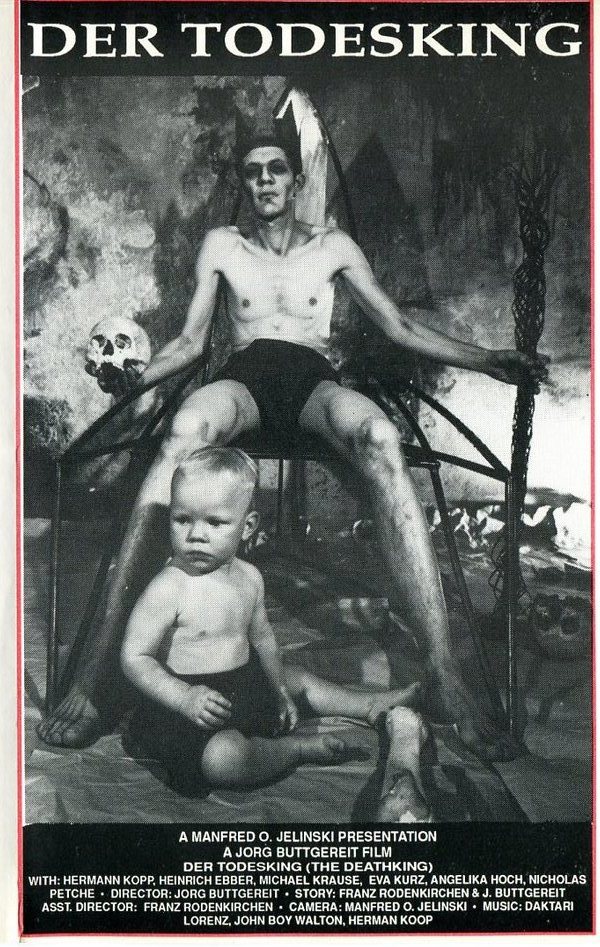
Well, I promise that we’re not going to just talk about NEKROMANTIK.
No. I don’t care. I’m just trying to explain the kind of attention I get from people like you on one side, but when I do stuff over here in Germany – stuff that’s not so shocking in the first place – I have a much wider audience. I think it’s something like 100,000 people a day who listen to my radio play. To sell 100,000 DVDs of NEKROMANTIK – it’s not possible.
What is the website for your radio plays?
It’s WDR. If you go to my Facebook account, on some of the older postings, you might see a link. It was last month, so I’m not sure if you can still download it.
Tell us a little about GREEN FRANKENSTEIN + SEXMONSTER.
This is an actual stage play that they do two or three times a month since last September, in Dortmund. This stage play is based on two radio plays that I did: GREEN FRANKENSTEIN + SEXMONSTER. As the audience, you enter the theater, you sit down, and on the stage you see cinema seats, and all the extras come onstage and sit facing you. They pretend to be seeing a movie and doing all the voice-overs and stuff – like they are dubbing something you don’t see. It refers to Japanese monster movies and sexploitation movies from the seventies, so it’s kind of educational also. You have a narrator who explains stuff in between. I had been asked to do this stage play and I was too lazy to come up with new topics, so I took two of my radio plays and started rehearsing with professional actors. Have you seen – it is also out on DVD – my CAPTAIN BERLIN VERSUS HITLER?
No. I haven’t seen that yet.
That’s more like a traditional stage play, and we filmed it. There was a nice trailer on YouTube. Captain Berlin is like Captain America, a superhero, and that is also based on a radio play I did. A friend of mine shot the whole stage play with different cameras and we made a film out of it. It’s mainly like Ed Wood did his films in the fifties – cardboard backgrounds and people doing monster stuff. If you look at it on YouTube, it has like a 150,000 hits, which is amazing to me. I think even this – CAPTAIN BERLIN VERSUS HITLER – though you’ve never heard of it, has a much bigger audience than NEKROMANTIK.
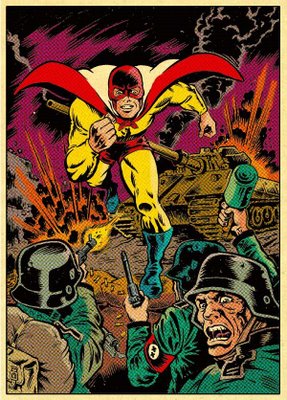
I’m still working in the same field with horror, superheroes, sexploitation, and monsters, but I don’t do it on the home movie level. I do it on the high art level. I do it on a stage in a theater next to an opera house, and people have to treat me seriously now.
I’m doing stuff that is even more childish than NEKROMANTIK.
How long have you been doing stage plays in Berlin? How long has your run been?
I think the first experience onstage was 2005. It was a musical actually, and I hate musicals. I was given an offer to do a German version of an Australian musical about the Ramones. I did the German version of a musical called GABBA, GABBA HEY. Tommy Ramone, the last surviving member, came over to Berlin and coached the band. In 2008, I did CAPTAIN BERLIN VERSUS HITLER for the stage. In 2009, we did the movie about it. Then I did a series of lectures in a famous theater over here. These were movie lectures about trash films – Naziploitation, action films, sexploitation. I did lectures for the film genres that have a bad name in Germany. The series was called Rough Cuts. After that, I started doing this stuff in Dortmund-GREEN FRANKENSTEIN + SEXMONSTER. Actually that’s a double-bill theater play. You have two sets and there’s a break in the middle, where you get popcorn and beer for free. It’s all part of the concept to tell people you are not in a theater, you are in a cinema – in a sleazy cinema in the seventies. I am going back there in October to direct a stage play about Edward Gein, which also was the inspiration for NEKROMANTIK. So I’m coming full circle.
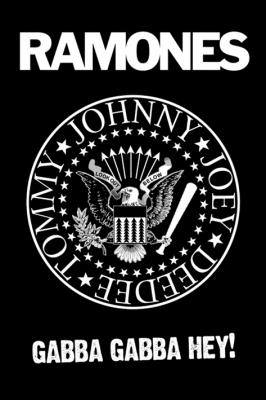
Now this series of lectures, where you talk about sexploitation and Nazi films, is this at all related to the upcoming VIDEO NASTY?
VIDEO NASTY was one evening of these film lectures. It’s ready, but we haven’t released it on DVD or anything, because it’s only a radio play. This one is a very straight – a radio play made on the stage with only one day of rehearsal. That was very rough. The funny thing is that it’s a radio play that works like an Italian zombie movie. For the German audience, the twist is that the actors onstage pretend to be actors in a bad Italian horror movie, and they are very well-known established stage play actors in Germany. If you don’t know that, then it might not be funny at all. Over here, it’s like you have these serious people, who do HAMLET and stuff like that, but now they are doing a Fulci zombie movie. Some of the actors are doing the dubbing voices of American actors. The main actress in VIDEO NASTY is the German voice for Angelina Jolie, for example. So you have these very strange combinations that only work in German, I’m afraid.
I want to talk a little bit about your documentary work. I know in MONSTERLAND, you cover a wide swath of the history of monsters in cinema and talk to such legends as Joe Dante, John Carpenter, H.R. Giger, Rick Baker, and Kenpachiro Satsuma. What was it like working with such genre icons? Can you tell us about your other documentary work, too?
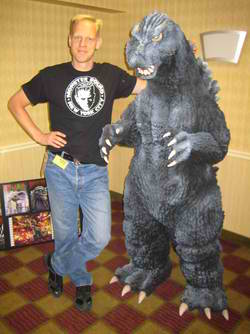
I was nervous. When you admire people, you have to hold back because you don’t want to look like a fanboy. So this was a very strange thing. One that went very well was H.R. Giger, the ALIEN designer, because he’s very shy. I worked with him on a German comedy called KILLER CONDOM, which was picked up by Troma for the US. And he was called the Creative Consultant, and I did the special effects, so we kinda worked together- which means we had dinner together and talked about stuff. He liked my movies a lot, and when he saw SCHRAMM he said it was one of his favorite movies. So it was this kind of connection I already had that made the interview with H.R. Giger much easier for me, because normally he’s not very happy with giving interviews at all. And after MONSTERLAND, he was not happy also: “Do I look like this?!” because he’s so shy.
But for me, the most interesting things were being in Japan and talking to people like Kenpachiro Satsuma, who portrayed GODZILLA and stuff like this. Meeting Joe Dante was really something normal, because he’s so open. He just talks to you, and shows you his little summer house next to his pool, all of the old Roger Corman posters his wall, and the old dusty Gremlin in the corner. So this was very easy. But in the end, I think Joe Dante didn’t know who I was. I gave him this book about NEKROMANTIK as a “Thank You” for the interview, and he was giving me funny looks: “You did this?!’ And I said “Yes.” And he gave me another funny look and we went off. So I never knew if he was impressed or shocked. But he didn’t believe me, for some reason.

MONSTERLAND was made for a TV channel called Arte. It’s a two country channel – Germany and France. And I also did some documentary work for them on a series called INTO THE NIGHT. The concept is two famous people spend the night together and we follow them with a camera. I did this with Asia Argento and Joe Coleman in New York. Have you seen that?
I watched some of them. I was very jealous that you got to work with Asia Argento. I’m guessing you will not give me her phone number.
I don’t have it. It was very complicated. If you do stuff like this for German and French TV, it’s complicated. You have to have this kind of commercial appeal, because it’s on TV. My idea was to do something about Joe Coleman, because I’m a big fan. I asked him if he wanted to do it and he said, “Yes. You’re the guy who did NEKROMANTIK. Of course, I’ll do it.” I told him that we needed someone for him as company for the night in New York: someone that might be more glamorous, so that the people from France would give me the budget. I asked him to get in contact with Asia Argento, because he knows her and that’s what he did. So he kind of closed the deal for me.
What normally do you have them discussing? Is it what comes organically, or is it about film or art?
That’s just up to them. We only ask them up front: What do you want to do? What do you want to eat? In what city to you want to spend the night? Then we try to arrange all the places for them; where we want to shoot. Then they do it in one go with no cuts. The good thing is that you shoot eight or ten hours and the movie is finished. The hard part for me, as the director, is to watch all the parts we shot. That’s two or three cameras at once – so 24 hours of footage; listen to all the stuff they talked about and get 53 minutes out of it. After that, you know these people very well. You only have about ten days of editing.

There’s a good thing about INTO THE NIGHT, because every hour you go to a different place and always the subject changes. After you listen to all the stuff and you do your notes, then you see if there’s a big theme or not. So it works on its own. It’s a lot of work, but it’s fun. You are going to listen even when they are driving in a car. You listen to people you are interested in, and that’s really exciting.
I think there would be an audience for that, because people have voyeuristic tendencies to begin with, and then you involve celebrities that they admire. You kind of get a look into how their thoughts work.
These kinds of programs are not sold to other countries very much. Some of them have been released on DVD over here. They are aired in France, Germany, Switzerland, and Austria only, I think – only in four countries.
It’s probably not over here because I think something like that would fall under reality television. We have a rule in America that if it’s reality television, it has to be as stupid as possible. So if it’s something that’s actually going to challenge or educate us, it’s forbidden. It can’t cross the border.
I see. So there’s no use in even asking.
As we discuss your work, NEKROMANTIK obviously keeps coming up. It might be that one day you are six feet under and your tombstone will simply read, “The guy who did NEKROMANTIK.” Deep down, are there any regrets about being the guy who did NEKROMANTIK? Do you wish you were defined in some other way?
In a way, this would make sense if NEKROMANTIK was a phenomenon like TWILIGHT or something. Something that is really big. As I was trying to explain to you, a lot of people talk to me about it, but it’s not big. It’s still an underground movie after all these years. I don’t get recognized on the street. If I go on a TV show next week over here in Germany, I just talk about the new stage play. It comes from the outside – from America and places like this – because over there, that’s the only stuff that’s visible from me. It’s very good that the fame with NEKROMANTIK is in the international market, because at home it’s not bothering me at all. Of course, a lot of people that hire me tell me, “I saw your film twenty years ago. I was shocked and I hated it, but do you want to work with me now?” In a way, it helps. But for a certain period of time, it was the opposite. My films were banned over here. Nobody was giving me jobs, of course. Everyone was afraid that if they hired this guy that they wouldn’t be able to sell the product afterwards.

Would you be where you are today without NEKROMANTIK?
That’s very hard to say. Even the theater attendant – guy who runs the theater in Germany – is a fan of mine from the early days and he hired me to do stage plays now. You can see that if I had been a serious stage play director in the first place, it might have been more difficult. But then I would probably do more classical stuff, not SEXMONSTER and GREEN FRANKENSTEIN on the stage. It’s very hard to say. In short, I think I was lucky that NEKROMANTIK got so much attention in one way, and then unlucky in another way because I had lots of trouble with it. This trouble was nearly being prosecuted for it and having my home raided by the police. Stuff like this also makes headlines for you. We have even been on the front page of Variety with the court case about NEKROMANTIK.
They actually raided your home back in the day?
Yes. They were trying to get hold of the negative in order to destroy it.
Wow. You have another facet to add to your career that many can’t identify with. I spoke with Stuart Gordon, and he’s a director whose tombstone might read, “This guy did RE-ANIMATOR.” But I’m pretty sure that he never had his home raided over it.
When I met him for the first time in South Korea, we were both on the jury at a festival in 2004. He told me that he worked for Disney. It was totally unbelievable for me that someone who did RE-ANIMATOR worked a steady job for Disney. Over here, it wouldn’t work like that. You are stigmatized if you do something like NEKROMANTIK over here. You don’t get jobs afterwards. It’s funny because I still have the laserdisc of RE-ANIMATOR that he sent to me, before I actually met him. He sent it from his office at Disney Studios. I thought that there was something wrong and I would have to ask him about it when I saw him. When I met him in South Korea, he was just this nice, fatherly guy. He doesn’t look like someone who did this insane movie. You can see that, in the US, you have a culture for this kind of thing. You don’t get suspicious about someone doing a movie like NEKROMANTIK. Over here it’s something bad. RE-ANIMATOR was banned in Germany as well.
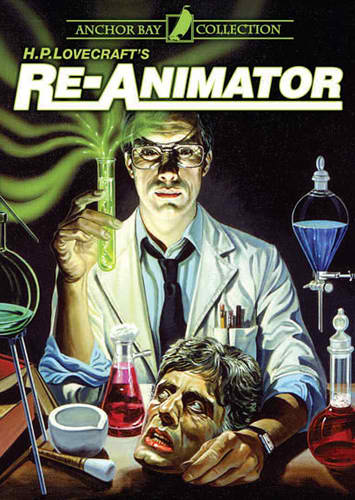
Twenty-five years after NEKROMANTIK, do you feel that the audience is more jaded or cynical? Is it harder to shock them?
I don’t know because I don’t try to shock them anymore.
You got out of that game.
Yes, because I did it so well that nowadays I’m trying to make fun of the expectation that I shock people. You saw the trailer of the stage play. Of course if it’s based on a radio play and it’s only the soundtrack of a movie you don’t see – there is no blood. Afterwards, the guy from the theater told me, “When I hired you, I was expecting a lot of blood on stage.” I did the opposite. I was showing nothing and I was showing something that was making fun of it. He was shocked by that, of course. It didn’t match his expectations. That has always been something fun for me to do – disappoint people’s expectations. If you have a look at NEKROMANTIK 2, you can imagine how painful it must be for the gorehounds to sit through these comedy scenes, until something is finally happening.
I don’t know if you keep up with it at all, but in the first HUMAN CENITPEDE, there’s hardly any gore. People were surprised. But in the second one, Tom Six showed you everything you expected to see in the first. Then everyone thought, “That’s horrible. I didn’t want to see that.” But I think they did. It was an interesting experiment, and what you are saying kind of reminds me of that. Have you seen either of these films?
I’ve not seen either HUMAN CENTIPEDE. As a writer for film magazines, I see all horror films that are going to be released in Germany. But these films are not released in Germany, because you can’t release them over here. After twenty-five years, TEXAS CHAIN SAW MASSACRE has finally been released uncut. I did a big special for it on DVD. Can you imagine a film from 1974 being released in 2012 for the first time?
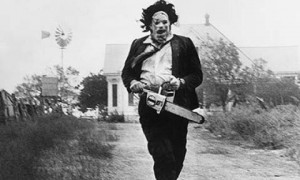
No. That was one of the first films that blew my mind.
Mine, too. But I was also kind of disappointed when I first saw it, because there’s no blood. In the seventies, the film was at the cinema. That was OK, but as soon as a video came out, it was banned all over Germany. That’s what happened in the eighties.
What are you currently working on? What’s next on the docket for you?
I just finished this BEAST OF FUSKUSHIMA thing, and I am now preparing a stage play about Edward Gein.

What’s that going to be called?
KANIBALE UND LIEBE (ed: CANNIBALS AND LOVE). There is a famous stage work by Schiller called KABALE UND LIEBE (ed: INTRIGUE AND LOVE), so this is a joke on high art stage plays.
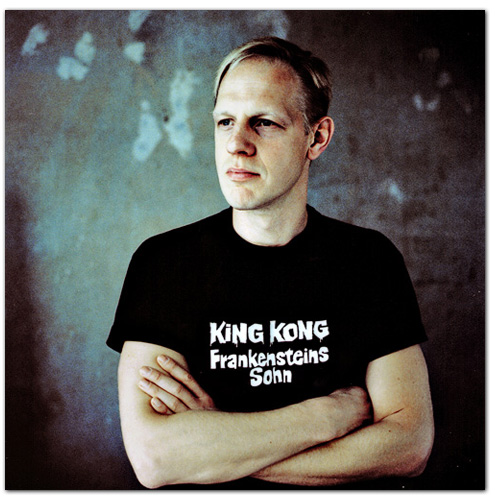
More to come, Bastards!
SPECIAL FEATURES:
Jörg’s official website
Jörg’s Facebook
Special thanks to:
for her transcription services!


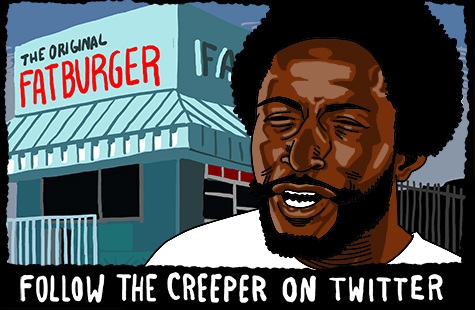

No Comments